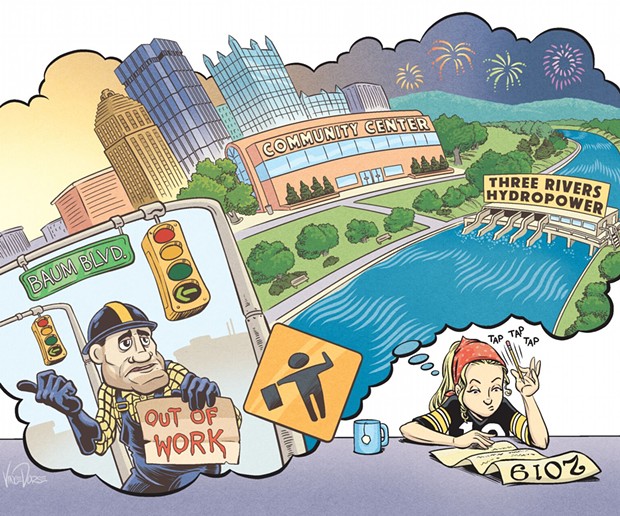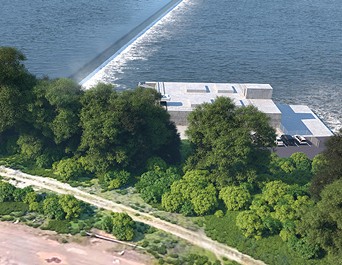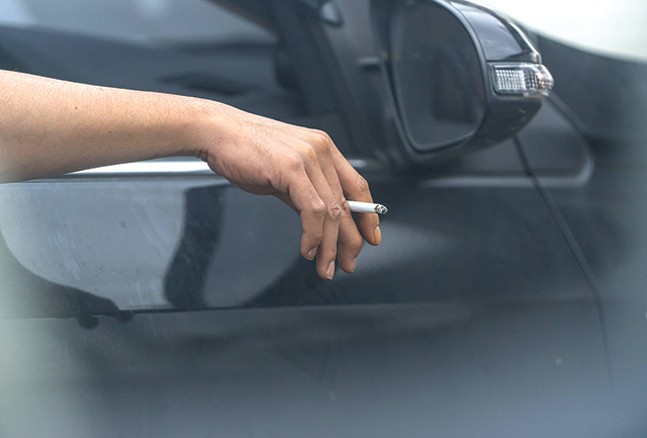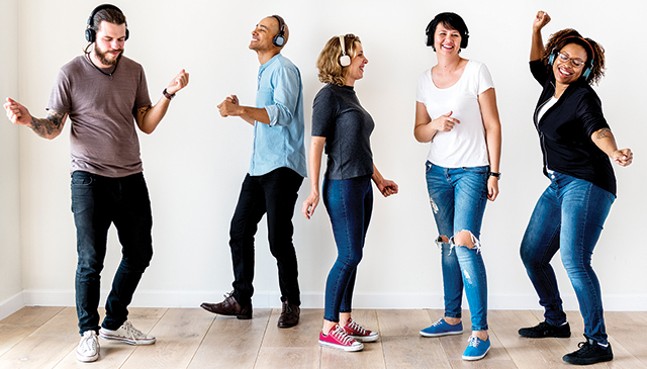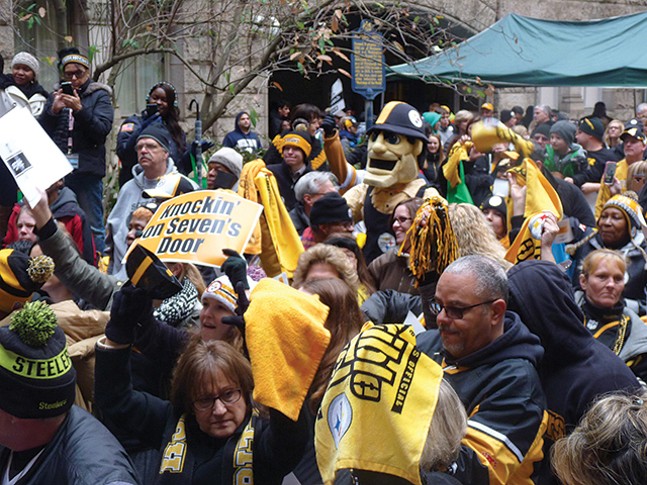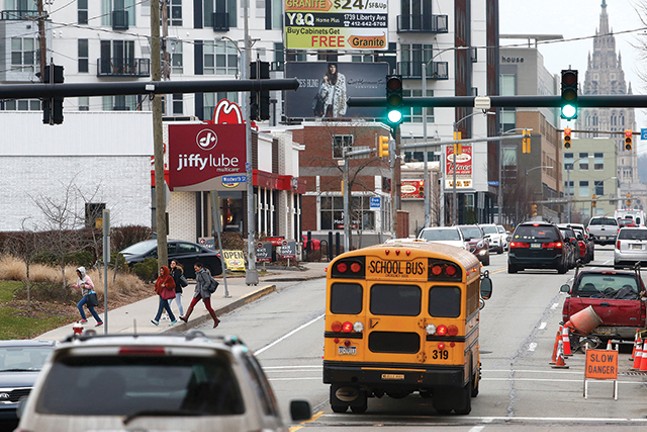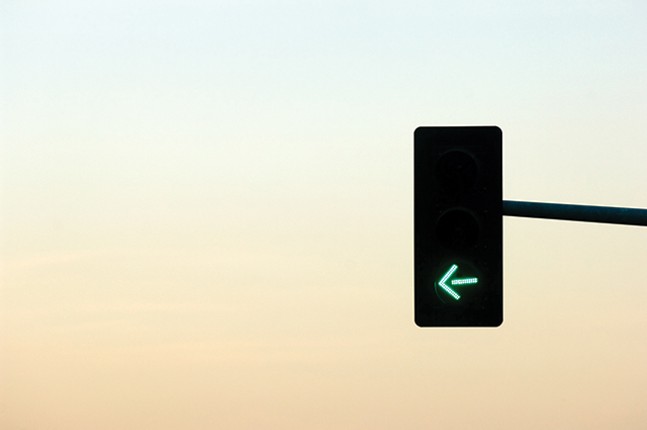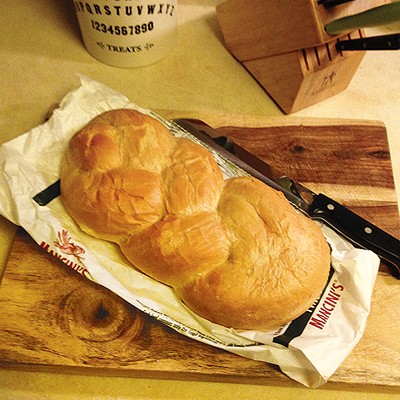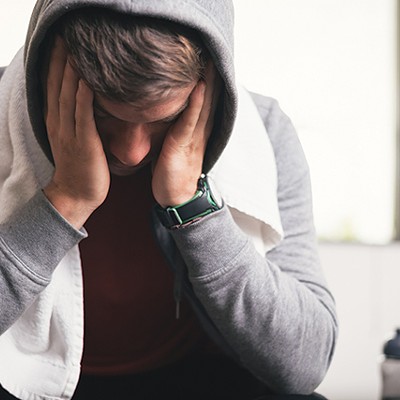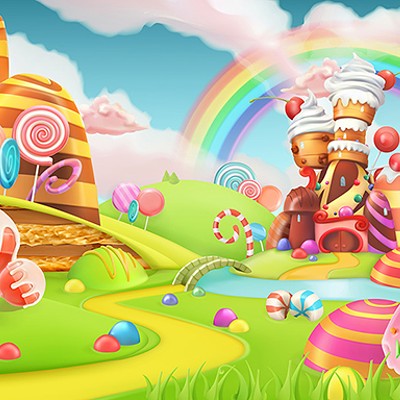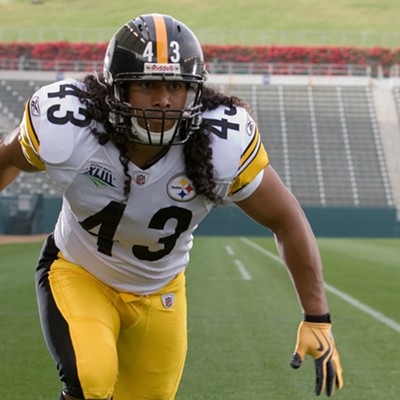Harness the Hydropower
By Amanda WaltzWater, water everywhere, and yet not a spark in sight. That’s the case in Pittsburgh, a river-rich city that has yet to grasp the true power-generating potential of one of its most abundant resources. But that may soon change.
Recently, the University of Pittsburgh made its largest-ever commitment to renewable energy when it agreed to receive 25 percent of its campus power needs from Allegheny River hydroelectric power. As part of the deal, Pitt signed a letter of intent to purchase 100 percent of the power from a low-impact hydroelectric plant to be constructed on the Allegheny River at the existing Allegheny Lock and Dam No. 2, located just below the Highland Park Bridge. (It’s expected to open in 2022).
As stated in a press release about the arrangement, the plant at Allegheny Lock and Dam No. 2 will be the first of eight potential hydropower facilities planned by Rye, a Boston-based hydropower developer, to capture energy from the Allegheny, Monongahela, and Ohio Rivers.
However, the same statement pointed out that it’s been nearly three decades since a new hydropower facility was constructed on the Allegheny River.
So while the deal is a positive, severely overdue move in the right direction – especially for an entity with as much clout and buying power as Pitt – it would be nice to see it expand, and quickly. And if climate scientists have anything to say about it (and they do), the city needs to get in gear if it wants to stop contributing to a potential worldwide catastrophe.
After all, Pittsburgh has rivers. So many rivers. More rivers than we know what to do with. Why not take advantage of them, especially when cities are scrambling to reduce their carbon emissions? Where was the mention of hydropower when Mayor Bill Peduto promised to power Pittsburgh with 100 percent renewables by 2035, a response to President Trump’s mention of the city in his 2017 anti-Paris Accord statement?
Sure, wind turbines are nice, but the city’s geography isn’t suited for them. And solar is great too, even if it does require some personal investment. As far as Pittsburgh is concerned, hydro should be where it’s at.
Solar and wind may have risen in popularity, but the U.S. Energy Information Administration positions hydropower as the largest source of renewable energy in the country. In 2017, it accounted for about 44 percent of electricity generated from renewable energy and 7 percent of the total U.S. electricity generation.
So come on, Pittsburgh. Turn that sometimes sewage-choked river water into gold. Invest in hydropower.
Get smokers off Pittsburgh’s rush-hour sidewalks
And into our Ubers
By Josh OswaldIt takes a Steel City constitution to hop off the Red Line T at 8 a.m., crack a Monster Energy tallboy, and fire up that cig like the coke-smelting furnaces of our recent past. But those of us who aren’t as Pittsburgh strong may struggle with a wakeup call from the Philip Morris Rooster.
Despite chapter 880 of the Allegheny County code, neither the Common Use Area, Passageway, or any of arbitrary distances from entrances can keep cigarette smoke out of the faces of sidewalk commuters. I’m not interested in telling people how to live. I may have had a cig or two in my day. Let’s just find a way our two parties can peacefully coexist.
Pittsburgh is a city of firsts. The first Ferris Wheel, commercial radio station, and the first civilization to subsist solely on potato products. It’s time we set another precedent. Let’s marry our steely past with our tech-boon present and introduce the Smoker’s Uber. The infrastructure is in place. We have the smokers, we have the Ubers.
Accessible from literally any sidewalk where morning smokers smoke, why not request a Smoker’s Uber and savor that Winston in the warm comfort of Chad’s Outlander Sport? Riders will have no choice but to listen to The Fan. There will be mints and Axe Body spray for those who have morning conference calls. And since autonomous Ubers crash every 15,000 miles, the service provides the same Russian Roulette thrill of smoking a cigarette.
Downtown Community Center
By Ryan DetoEating fast food in Downtown Pittsburgh can be a bit overwhelming. McDonald’s, Burger King, Wendy’s, and Arby’s are typically packed with customers waiting in line. The staff is overwhelmed, and the tables are filled with people chatting loudly and messing around. This isn’t necessarily a bad thing, but it feels like a displacement thing.
Several places Downtown have become de facto community centers. Youths, the homeless, workers, and residents gather en masse in just a few locations that feel welcoming to everyone, regardless of income or status. There is clearly a demand for places where people can hang out indoors, have food, and enjoy some entertainment. Inclusive places that are the opposite of the private, wealthy spaces like the Duquesne Club.
But it’s sad that those places are fast-food restaurants, run by multi-billion-dollar corporations that pay poor wages and make Americans less healthy. We are letting the 1 percent provide a Downtown necessity, and let’s be honest, it’s far from ideal.
Let’s change that. Downtown needs a public, indoor community center. It needs a place where kids waiting for the bus can spend time. Maybe computers and tutors can be provided, so they can do homework. Board games, couches, and tables can give them a place to hang out, maybe calm the tensions that exist when they’re stuck outside for hours, unsupervised. The Carnegie Library of Pittsburgh’s Downtown branch provides some of these services, but clearly, there is demand for more space and more services.
A potential community center could provide the homeless and jobless a place to keep warm in the winter and cool in the summer. Maybe career counselors can help them look for work. Maybe a community food kitchen can help provide some food.
Heck, maybe the center could provide a place for people just to gather, watch a Pirates game and let white-collar workers interact with the service workers that keep their offices clean.
Everyone says we are in a divided time in America. Why not have local government create a place that fosters camaraderie among groups that rarely interact?
This wouldn’t be an easy undertaking, but that shouldn’t stop Pittsburgh from trying. There are several properties Downtown that have sat vacant for years. Pittsburgh City Paper offices are next door to several vacant buildings on Smithfield Street. Surely one or two could be converted.
Funds are always an issue for these kinds of projects, but there are missed opportunities the city could take advantage of to help pay for them. Just to take an example at random, there are millions in uncollected revenue, because Amazon isn’t collecting sales tax on online purchases in Allegheny County. In a statement to CP, Amazon representatives indicated they wouldn't be against collecting the sales tax if the state legislature altered the law to force them to collect.
Then that extra sales-tax revenue could be funneled to the Allegheny County Regional Asset District, which funds community assets like parks, libraries and museums. A city- or county-owned community center would easily fall under that jurisdiction.
It’s past time we provide some comfortable space for the large crowds that congregate Downtown each day.
Logical Liquor laws
By Hannah LynnIn 1933, the governor of Pennsylvania was a man named Gifford Pinchot. He loved forestry and had a staggering moustache. He was also a big fan of prohibition, and when the act was repealed nationwide, Pinchot established the Pennsylvania Liquor Control Board (PLCB) to make buying alcohol “as inconvenient and expensive as possible." The PLCB still runs all state liquor stores, and it’s still inconvenient as shit.
The alcohol content between beer and wine is much more similar than that between wine and liquor. But in Pennsylvania, most wine and liquor are sold at state-run stores while beer is sold at distributors. Due to recent changes to that law, wine and beer are available at some grocery stores and gas stations. However, in Pittsburgh, this mostly means Giant Eagle-owned establishments. Bars can sell six-packs, but not wine or liquor. Breweries and distilleries can sell their products at their own establishments and sometimes at farmers markets. If you’re lost, blame Ol’ Pinchy.
There are several moves that can be done to straighten out this mess, like allowing liquor sales at all grocery stores. Sometimes I fantasize about the infamous two-dollar wine sold at Trader Joe’s in other states. Having liquor stores that are not state-run would be nice, but that would involve the state giving up a billion dollars in revenue. Is it too much to ask for lax open container laws? It would be fun to drink in the park. It doesn’t seem more dangerous than open carry laws.
If anyone from the government, the liquor board, or the ghost of Gifford Pinchot is reading, please make it easier to buy alcohol. Earth is very stressful and we’re still a ways away from legal weed.
Noise Complaints
By Jordan SnowdenOutdoor concerts are ubiquitous in Pittsburgh during the summer: the sun sets late, and the city starts to cool off. Just as you start to get comfortable, the music suddenly comes to an end.
Once the clock strikes 10 p.m. in Pittsburgh, sound above 55 decibels could result in fines or, if the venue serves alcohol, the potential loss of its liquor license. But late-night musical excursions are a key factor of thriving music scenes in places like Austin, Texas, where music can be heard in the streets long after the sun has set.
Earlier this year, after a ten-month process that included input from more than 1,800 musicians and civic leaders, the Pittsburgh Music Ecosystem Project released a study detailing how to grow the local music scene. The study was developed by Sound Music Cities, Inc., an Austin-based company that promotes positive community and economic growth within music communities. Don Pitts, who worked with Austin’s Economic Development Department’s music and entertainment division, assisted with the project. While working at the department, Pitts effectively reduced Austin’s noise complaints by 70 percent.
One of the suggestions on how to combat sound complaints was to petition for a noise ordinance exemption in certain parts of the city, allowing for music-friendly districts. Those specific areas would operate under a city-run special sound ordinance.
Noise-friendly districts with music flowing freely into the night are a spectacular idea. But getting laws changed can take a long time. So for 2019, I propose a silent disco bar (with an outdoor area for when it’s nice).
A silent disco is a dance event in which music is piped into attendees' wireless headphones, reducing noise to not much more than shuffling feet. Want to chat with a friend? Take the headphones off. Music too loud? Turn the volume down. Too low? Turn it up. There are even more advanced silent discos, where the headphones give the option to flip between two different channels. For example, one frequency could be tuned into a funk band, while the other plays indie rock.
Not only would excess noise no longer be a concern, people could dance, party, and mingle late until the night. No petitions required.
Here He Goes, Steelers
By Lisa CunninghamGive me a plate of pierogis over a cheesesteak. I'll hang out with yinz before youse. But I'm sorry, Pittsburgh, the City of Brotherly Love kicked our ass this year when it introduced a new hero for the people. He's big, jolly, orange, batshit insane, and FABULOUS. Gritty, the new mascot for the Philadelphia Flyers, debuted in September, jiggling his big belly and rolling his oversized googly eyes into all of our hearts.
Gritty almost instantly became one of the most popular memes of 2018 and was adopted by leftists as a liberal icon soon after. In the arena, fans cheered as he slid around and fell down on the ice like a champ. When Trump came to town, protesters took to the streets with Gritty signs saying, "This town only has room for one orange asshole," and "GRITTY SAYS 'GTFO OF PHILLY.'"
Meanwhile, back in Pittsburgh, a Steely McBeam doll with an oversized jaw and a dumb smile permanently stuck on his big dumb face lays abandoned in a ditch because, seriously, who wants him as a mascot, let alone an icon, for anything? No one. He shows up in the Bloomfield Halloween Parade and people wish the costume was wearing a costume.
I'm a proud member of the Facebook group Gritty Memes for Philly Teens, along with 18,000 other folks. I'm cheered up almost every day when someone posts a new Photoshopped image of Gritty. People all over the country, not just Philadelphia, are making Gritty cookies, Gritty hats, Gritty Christmas ornaments. Last week, someone posted a photo of a Gritty-shaped latke. The love for Gritty doesn't just cross city lines; it's a powerful force with the ability to end cultural and religious divides.
It's time to replace Steely McBeam with our own Gritty.
Here we go, Steelers, here we go. Pittsburgh wants you to take a new mascot to the Super Bowl. Might I suggest it not be a big dumb white man? The one we have at quarterback is probably enough. In 2019, let’s take Steely to the salon and give him a makeover. Stuff some plates of Primanti sandwiches and haluski down his face, fatten him up. Get rid of those tight clothes. Replace his head with an oversized ball of black and gold fur.
Our hockey and baseball mascots can stay. The PNC Park pierogis, the Eat'n Park cookie, and Kenny the Kangaroo, too. But Steely McBeam has been a part of the Steelers organization since 2007 and can you once remember seeing his face on someone's shirt? Has anyone ever carved a Steely McBeam pumpkin for Halloween? If they did, I bet it looked as dumb as his face.
Easier ways to load connect cards
By Hannah LynnConnectCards are a great tool for riding Port Authority transit. They make boarding the bus more efficient and cheaper than paying with cash. They can be loaded with unlimited daily, weekly, monthly, or annual bus passes. Depending on how often cardholders use public transit, these passes can save a lot of money. Personally, I get a monthly bus pass on the first of every month. It costs $97.50, which evens out to $3.14 a day. I take the bus a minimum of twice a day, which would be $5+ a day without a pass or ConnectCard.
Despite the convenience and cost-effectiveness of the card, Port Authority does not make it easy to reload. The ConnectCard website features a difficult-to-read list of locations and businesses where customers can load cards. While the list is long, the locations are not evenly spread out. With some exceptions, places that load ConnectCards mostly include Giant Eagle, Goodwill, and kiosks at busway stations. Cards can be loaded on the ConnectCard website, but that's not convenient for those paying with cash.
I live in a central location in Bloomfield, so if it’s slightly inconvenient for me, it’s certainly even more inconvenient for others.
Some propositions: more kiosks, not just at busways. Card loading available at more locations, like convenience stores, libraries, gas stations, and pharmacies. Locations should be as widespread as possible, both because of need, and because everyone should be encouraged to use public transportation.
Editor's note: A previous version stated that it isn't possible to load ConnectCard passes online. This is incorrect and the article has been updated to fix the mistake. Now if they could only let me load my ConnectCard through telepathy!
Designated places to set off fireworks
By Amanda WaltzPicture this: it’s summer. You’re on your back patio enjoying one of the few sunny Pittsburgh days, cold beer in hand, dog at your side. Then all of the sudden, BLAM! Your backyard becomes a miniature war zone, the dog runs away in fear, and the day is officially ruined.
This is the reality in Pittsburgh since the state recently made it legal for consumers to buy the higher-grade, aerial fireworks banned in Pennsylvania since 1939. This extends to items containing up to 50 milligrams of explosive material, including Roman candles, mortars, and bottle rockets.
Since then, residents all over Pittsburgh have had to deal with inconsiderate neighbors setting off loud, potentially dangerous fireworks for weeks before and after the Fourth of July. This, despite the fact that it’s illegal to set off fireworks within 150 feet (or 10 car lengths) of occupied buildings, a law that I can tell you firsthand is definitely not followed by certain people in my neighborhood.
So what to do? You could petition the local government to ban fireworks from the city, as they cause injuries, property damage, and other disturbances. You could flood 911 with noise complaints about fireworks going off near your house until, finally, police decide to do something about it (and yes, you’re supposed to call 911 for noise complaints).
Or we could just designate areas far, far from the city where explosion-happy jerks can make big noises and blow their fingers off to their heart's content without disturbing people (especially those with PTSD) or pets. Maybe in a dome-like stadium? Or at the bottom of a ravine? How about in an abandoned warehouse they were going to burn down anyway? The possibilities are endless.
Redesign Baum Boulevard
By Ryan DetoMost of the East End is a pedestrian's paradise, but some parts feel out of place.
These sections are typically remnants of urban renewal, a post-WWII development strategy meant to clear blight out of urban neighborhoods. In actuality, redesigns focused on attracting car-focused suburbanites, but ended up decimating city neighborhoods, especially majority-Black ones, because the strategy favored huge Brutalist architecture surrounded by giant parking lots and what were basically highways. Not exactly a nice place to live.
As a result, neighborhoods like East Liberty were made worse. But now, city leaders are taking steps to improve East Liberty’s urban-renewal scars. Bike lanes have given people an alternative option to driving, and walking is better since traffic is slowed down. Four-lane, one-way streets are being converted back to two-way streets, with improvements to pedestrian and cycling infrastructures. Complete Streets, the idea to weigh the needs of drivers, cyclists, and pedestrians, is taking hold.
But, one major thoroughfare is being ignored, and it cuts through the East End with reckless abandon: Baum Boulevard.
This four-lane road is cold and barren, filled with drivers that regularly speed. There is consistently congestion by drivers waiting to enter fast-food drive thrus. A road designed to increase traffic flow is often slowed because it’s also designed to cater to the material needs of drivers. It’s insanity.
Furthermore, Baum Boulevard contains blocks where cars can park in lanes near the curb, effectively turning a four-lane road into a three- or two-lane road. On top of that, periodic viewings of Google traffic on Baum during rush hour show large-scale congestion rarely happens.
Honorably, the new apartment complex Ollie at Baumhaus created a green barrier between pedestrians and cars on their section of sidewalk. It’s the most pleasant part of Baum, but it’s a band-aid on a massive, gaping wound.
Solution? Redesign Baum Boulevard. Reduce four lanes to two, with sections where drivers can wait to make left turns at intersections or into drive thrus without stopping traffic flow. Cars would also be discouraged from speeding, since left-turn sections would force drivers to follow a meandering path, like the section of Penn Ave. between 40th and 45th streets.
One of the eliminated lanes could provide space for a protected bike lane that would offer vital connections to other bike lanes in Bloomfield, Friendship, and East Liberty, and eventually North Oakland. The other eliminated driving lane on Baum (where it isn’t used for left-turn sections) could be converted into additional parking or parklets for trees and green space.
Baum could be transformed into a Complete Street sanctuary.
Beyond Megatouch
by Alex GordonPacking a taproom with 1980s arcade games and slapping an easy portmanteau out front may strike some as excessively trendy, but don't knock it until you've tried it. Throw back a few beers, level several city blocks in Rampage, and see how you feel about it then.
Barcade™ is credited with debuting the drinking/gaming concept in Brooklyn in 2004 — though, to be fair, one of the first arcade cabinets ever was actually installed in a bar in the early 1970s. The company now has locations around the country (even in nearby Philadelphia, which isn't nearby). They have some competition, hence the 2007 court case to secure the ™, so clearly the video games-plus-drinking formula has something going for it. We should get on board.
Traditionally, Pittsburgh is more of a pinball town, but no one's ever gone broke underestimating Pittsburghers' penchant for drinking beer and playing games. We're already stacked in general-gaming bars (Kickback, Games N' At, Victory Pointe), but none fully committed to arcade games, which is the best way to get your joystick muscles back in fighting shape. Plus, given Pittsburghers' appetite for nostalgia, it’s a safe bet the throwback games would make bank. Who wouldn't want to get tipsy and sample old favorites like Frogger and Pac-Man?
It’s settled: Let's bring a Barcade to Pittsburgh in 2019. If they're not interested, we'll build our own and call it Juice and Joysticks. Or a different, better name.
Pittsburgh Left Ain’t Right
By Lisa Cunningham“People just need to learn how it works.”
That’s what someone told me when I said the Pittsburgh Left needs to go. Listen, if everyone who drove a car in Pittsburgh was courteous and watched out for cyclists and pedestrians and actually cared about people other than themselves, maybe. But let’s be honest, they don’t.
The Pittsburgh Left is an unwritten rule of the road, in which the first left-turning vehicle at an intersection is given right-of-way over the opposing traffic going straight. Drivers here tend to expect the move.
Who cares if the driver in the oncoming traffic isn’t from Pittsburgh and has no idea what you’re about to do, right? “You’re in PITTSBURGH, buddy. Learn to speak our language!”
This aggressive behavior is so expected that drivers in left-turn lanes often gas it before the light even turns green, just so they can shave off a few seconds from their commute. They’re not just doing this when there are a line of cars waiting to go. They do it even if it’s just a two-car faceoff. It’s not just silly, it’s dangerous.
As a pedestrian, I’ve almost gotten hit multiple times while crossing the street and coming face-to-face with one of these drivers, so intent on making the Pittsburgh Left that their gazes are transfixed on the light and not on their surroundings. As a driver, I’m extra cautious of Pittsburgh Lefters and sometimes sit at the light forever, waving my hands and flashing my headlights at the other driver doing the same exact thing, only to have both of us eventually give up and pull out at the same time.
The Pittsburgh Left is exhausting.
Let’s eliminate it in 2019 by providing a reason for it to no longer be needed: Install more left turn signals at lights.
Until then, try to leave your house a little earlier, suck it up, and wait your turn. And for god’s sake, stop honking your horn if someone in front of you chooses not to put their life in danger by participating in this ridiculous tradition.
Great Taste, Zero Waste
By Maggie WeaverImagine a world where Pamela’s Diner installs an in-house composting system, turning leftover pancakes into a renewable resource. Prantl’s Bakery serves cakes in 100 percent biodegradable boxes. Crazy Mocha gathers used coffee grounds, blessing local farms with free fertilizer. Southern Tier offers to recycle and reuse glass bottles, designating taproom collection points.
U.S. restaurants waste 11.4 million tons of food annually. That’s an average of $390 per customer, tossed into a dumpster. And that’s just food. Zero waste is a buzzword in the food industry. But the rising trend that hasn’t quite made it to Pittsburgh, though the city — thanks to the community — is on its way.
In practice, zero waste doesn’t reduce waste entirely. It’s just an ideology, encouraging reuse and redesign to limit careless waste. Restaurateurs allow patrons to use toilet paper, but switch from paper towels to hand dryers. Chefs practice nose-to-tail and root-to-stem cooking, a technique that uses all parts of a vegetable or meat.
There's money to be made in waste management. Creating a mindful menu with smaller portion sizes and a decreased range of ingredients lowers food costs. Sometimes, it’s as simple as a question. Asking a guest if they need a straw or bag lessens use of non-recyclable plastic. But tracking and analyzing waste, two of the most profitable tactics, are more involved.
For many restaurants, it’s a competition between feasibility and profitability. It takes time, energy, and funds for a waste audit. With an average profit margin of three to five percent and constant business competition, money for composting and waste tracking is practically nonexistent.
Other roadblocks hinder Pittsburgh restaurants’ ability to go waste-free. Many rent properties and face regulations from landlords, especially regarding the smell of compost. With new codes in the South Hills, businesses may not be able to recycle glass.
Organizations like Sustainable Pittsburgh Restaurants (SPR) and 412 Food Rescue are stepping up to offer support and resources for waste reduction. Early this fall, SPR initiated the Straw Forward project, an opportunity for restaurants to donate straws for community art.
The David L. Lawrence Convention Center manually sorts waste with hockey sticks. KayaFest, a summer event held by Kaya, was completely waste-free. Three area restaurants are participating in the Oyster Recovery Partnership, collecting shells to help restore the Chesapeake Bay's oyster population.
Restaurants in the city are making leaps and bounds towards waste reduction. But in comparison to other cities, Pittsburgh is still behind. With local initiatives and community support, 2019 will hopefully bring the city’s first zero waste restaurant.

